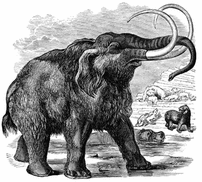
By now you've probably heard of cloned sheep, cows, chickens, dogs and cats. But cloned mammoths? That's science fiction, right? Well, not quite. Apparently, scientists from Russia and South Korea have signed on to a joint project to clone a wooly mammoth using ancient DNA and elephant cells. The project is headed by Korean cloning pioneer Hwang Woo-Suk.
Suk has already generated controversy by some of his claims in human cloning that were later proven to be untrue. In this instance, however, he insists his methods are on the up and up.
Basically, the team intends remove the nuclei from the ova of an Indian elephant and inject cells retrieved from the remains of a mammoth embryo. Will it work? The last mammoths roamed the earth 4,500 years ago. Theories vary as to the cause of their extinction. Some scientists attribute their demise to warmer temperatures and retreating glaciers. Others claim human hunters drove the beasts out of business. Now, it seems, that humans may be on the verge of bringing them back. Stay tuned (but don't hold your breath.)
Links
If you want to learn more, you can read articles in the Vancouver Sun or UK Daily Telegraph. More about the sequencing of mammoth DNA, here and if you want to read up on mammoths in general, the Illinois State Museum has an excellent mammoth page.
Picture Credit:
Florida Educational Technology Clearinghouse
Suk has already generated controversy by some of his claims in human cloning that were later proven to be untrue. In this instance, however, he insists his methods are on the up and up.
Basically, the team intends remove the nuclei from the ova of an Indian elephant and inject cells retrieved from the remains of a mammoth embryo. Will it work? The last mammoths roamed the earth 4,500 years ago. Theories vary as to the cause of their extinction. Some scientists attribute their demise to warmer temperatures and retreating glaciers. Others claim human hunters drove the beasts out of business. Now, it seems, that humans may be on the verge of bringing them back. Stay tuned (but don't hold your breath.)
Links
If you want to learn more, you can read articles in the Vancouver Sun or UK Daily Telegraph. More about the sequencing of mammoth DNA, here and if you want to read up on mammoths in general, the Illinois State Museum has an excellent mammoth page.
Picture Credit:
Florida Educational Technology Clearinghouse